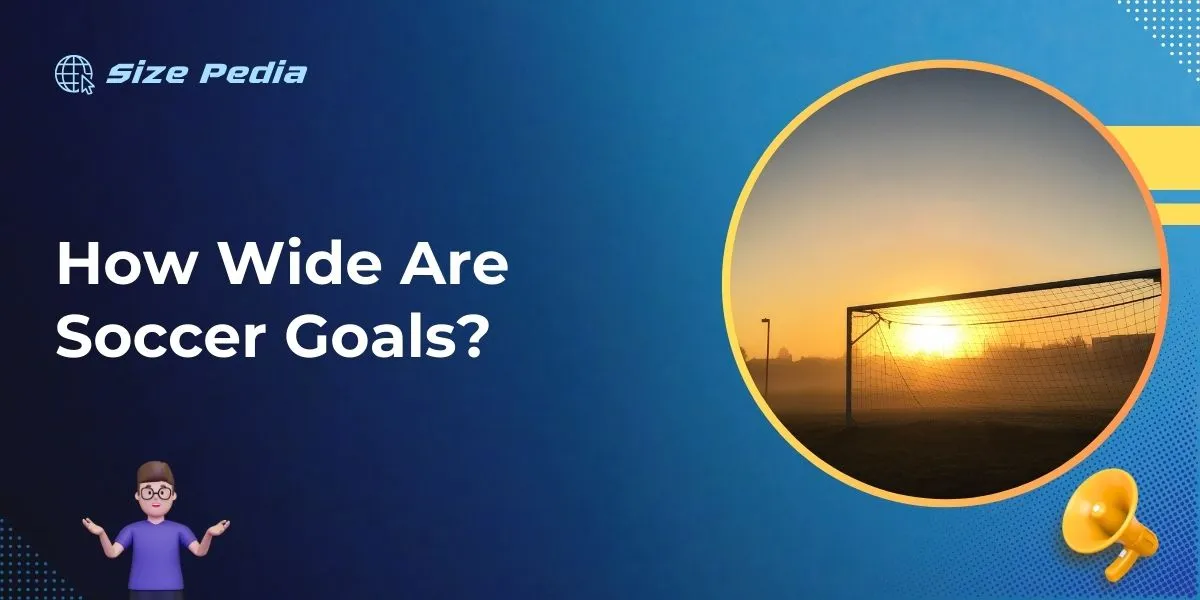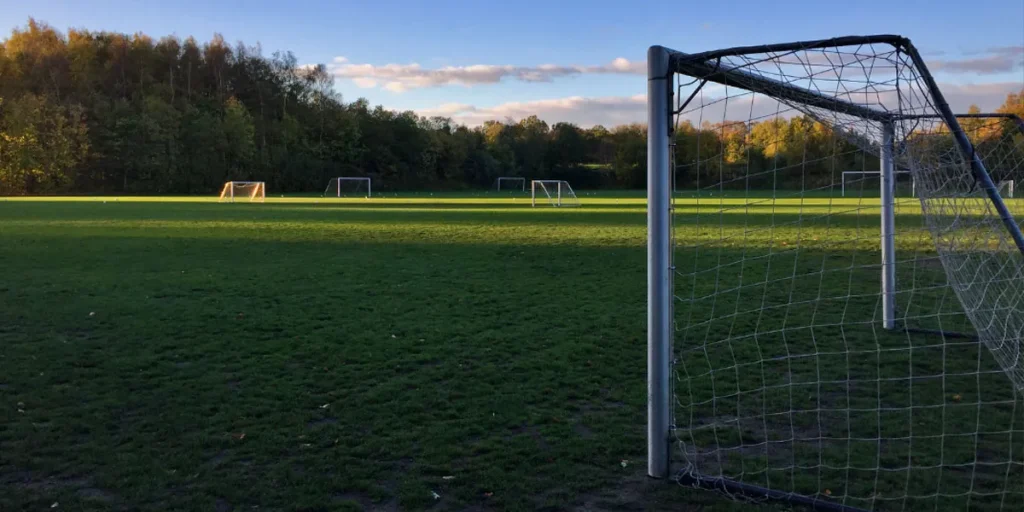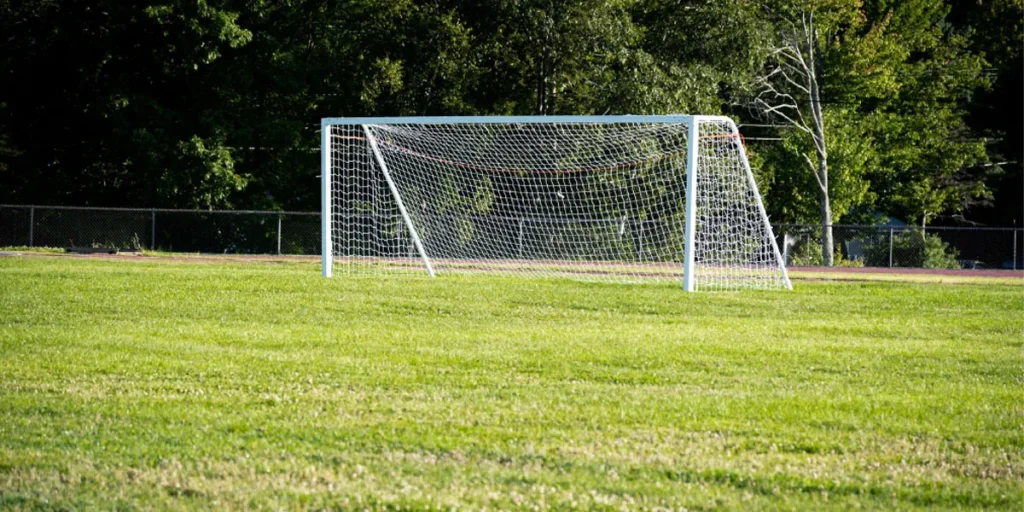Soccer goals are 24 feet wide by 8 feet tall. Standard goal dimensions apply to professional matches.
Understanding soccer goal dimensions is crucial for players, coaches, and enthusiasts alike, as it impacts game strategy and equipment choices.
The width and height of soccer goals remain consistent across professional leagues around the world, including major tournaments like the FIFA World Cup.
This measure is essential for those setting up training sessions or leagues at any level, ensuring that the playing conditions meet official standards.
A well-rounded familiarity with these dimensions aids in appreciating the game’s requirements and helps in creating an engaging, competitive environment.
Soccer’s popularity hinges on its clear, globally recognized regulations, which include the exact goal sizes for all competitive matches.

Soccer Goals History
Delving into the history of soccer goals unveils a journey from rudimentary beginnings to standardized fixtures.
The evolution of soccer goal dimensions reflects the sport’s development from informal matches to the well-regulated game we celebrate today.
From Pasture To Pitch
The roots of soccer stretch deep into the past, with goals that had no formal size. Early players would use natural markers or simple objects to create goalposts.
These ad-hoc games in villages often saw goals of diverse and arbitrary widths.
- Cloaks as goalposts – A common approach in the game’s infancy.
- Trees lining fields – Natural boundaries as makeshift goals.
- Differing regional sizes – Each locale with its own goal width.
Regulating The Game
As the sport gained popularity, a pressing need emerged to standardize goal size. The Football Association took the leading role in the late 19th century, cementing goal dimensions in their rulebook.
| Year | Regulation |
|---|---|
| 1863 | Formation of The Football Association. |
| 1875 | Introduction of the crossbar to replace tape. |
| 1882 | Official goal sizes specified: 8 feet high, 8 yards wide. |
These established measurements provided consistency across pitches, legitimizing competitions and fostering global understanding of the game.
Standard Dimensions
The size of soccer goals can vary depending on use and age group. Yet, there are established measurements for official matches.
These dimensions ensure a uniform playing experience worldwide. The width and height of the goal directly affect gameplay.
It is crucial for players and coaches to know these standard sizes.
International Match Standards
For professional and international soccer, the goal size is strictly regulated. According to FIFA, the governing body for soccer worldwide, the standard dimensions are as follows:
| Part of Goal | Standard Measurement |
|---|---|
| Width | 24 feet (7.32 meters) |
| Height | 8 feet (2.44 meters) |
| Depth | 5 feet (1.5 meters) |
These dimensions apply to all international matches, including the World Cup.
Youth Soccer Adjustments
The size of goals changes in youth soccer to accommodate players’ abilities and sizes. Smaller fields require smaller goals.
This helps young players develop their skills without being overpowered by adult-sized goals.
- Under 6 to Under 8: Goals are usually 6 feet wide and 3 to 4 feet high.
- Under 9 to Under 12: Goals can measure up to 12 feet wide and 6 feet high.
- Under 13 and above: The goal size gradually approaches the standard 24×8 feet.
These adjustments ensure a fun and fair game for all youth players.
Variations Across Leagues

From youth leagues to professional play, soccer goal sizes vary widely. Each league has its own regulations that dictate the dimensions of the goals used in their matches.
Understanding these differences is key for players, coaches, and fans alike.
Major Differences
Soccer goals come in a range of sizes. The International Football Association Board (IFAB) states that goals should be 8 feet high and 24 feet wide for standard adult play.
But, not all leagues follow these exact measurements.
- FIFA World Cup and UEFA matches stick to IFAB standards.
- MLS in the United States also uses these official dimensions.
- Youth leagues often have smaller goals, to suit younger players.
| League | Goal Width | Goal Height |
|---|---|---|
| Professional | 24ft | 8ft |
| Youth (U12) | 21ft | 7ft |
| Youth (U8) | 12ft | 6ft |
Reasons For Diverse Sizes
Several factors dictate goal size variations. Player age and skill level top the list. Younger players use smaller goals to match their physical size and abilities.
As players grow older and more skilled, the goal size increases, providing a consistent challenge.
- Player Development: Smaller goals for younger players aid skill growth.
- Safety: Appropriate goal sizes reduce injury risk for younger players.
- Standardization: Adult leagues maintain uniformity in goal size for fairness.
These tailored goal sizes help foster player development, from early gameplay to professional leagues.
Understanding goal size variations is crucial for optimal training and game preparation.
Impact On Gameplay
The dimensions of soccer goals directly shape the game’s dynamics. The standard width for a professional soccer goal is 24 feet (7.32 meters), significantly influencing players’ performances and decision-making on the field.
Tactics And Strategies
The width of a soccer goal dictates the offensive and defensive approaches teams adopt. Wider goals mean attackers have more space to target, while defenders must cover more ground to protect their net.
- Teams may favor long-range shots to exploit the width.
- Strategically placed crosses become more potent with wider openings.
- Defenders must excel at positioning to decrease scoring opportunities.
Goalkeeping Challenges
Goalkeepers face unique hurdles with the standard goal width. The expanse of the goal area demands exceptional agility and positioning from the keeper.
| Goal Area | Impact on Goalkeeping |
|---|---|
| Width | Goalkeepers must extend their reach and be alert to cover the wide post. |
| High Crosses | Wide goals challenge keepers to master aerial control and timing. |
| Angled Shots | The angle and pace of shots require swift lateral movement. |
Installation And Maintenance

Soccer goal installation and maintenance are key to ensuring a great game. Proper set up keeps players safe. Regular upkeep keeps the goal functional for every match.
Setting Up A Soccer Goal
Correct installation is crucial for player safety and game integrity. Follow these steps for setting up:
- Select the right spot: Make sure the ground is level.
- Measure the distance: Soccer goals are 24 feet wide.
- Anchor securely: Prevent the goal from tipping over.
- Inspect components: Check for damage to nets and posts.
Properly assembled goals create a safe and fair playing environment.
Keeping It Match-ready
Maintenance ensures a soccer goal remains safe and functional. Regular checks involve:
- Net inspection: Look for tears or weaknesses.
- Hardware check: Tighten any loose bolts or screws.
- Surface examination: Check for rust or paint damage.
- Clean regularly: Remove dirt or debris from the goal area.
Give attention to the goal before and after games for the best play experience.
FAQs About the Width of Soccer Goals
How Many Feet Wide Is A Soccer Goal?
A soccer goal is 8 feet high and 24 feet wide.
How Wide Is Professional Football Goal?
A professional football goal is 24 feet (7. 32 meters) wide.
What Size Are Premier League Football Goals?
Premier League football goals measure 8 feet in height and 8 yards in width. These dimensions are internationally standardized for professional play.
What Is The Width Of Football Goal Past?
The width of a standard football goal post is 24 feet (7. 32 meters).
Conclusion
Understanding soccer goal dimensions is crucial for players and enthusiasts alike. The standard width for adult goals stands at 24 feet, resonating with FIFA regulations.
Whether you’re setting up a match or honing your shots, remember these measurements for true game fidelity.
Embrace the precision; it could be the key to your next victorious goal!
Resources:
https://www.cpsc.gov/safety-education/safety-guides/sports-fitness-and-recreation/guidelines-movable-soccer-goals
https://www.dlgsc.wa.gov.au/sport-and-recreation/sports-dimensions-guide/football-(soccer)
